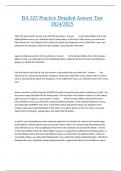Exam (elaborations)
BA 325 Practice Detailed Answer Test 2024/2025
- Course
- BA325
- Institution
- Portland State University
Filter the State column so only rows with MD are shown. Answer: In the Home Ribbon Tab in the Editing Ribbon Group, you clicked the Sort & Filter button. In the Sort & Filter menu, you clicked the Filter menu item. You clicked cell D1, clicked the Quick Sort dropdown. In the Table Filter me...
[Show more]



